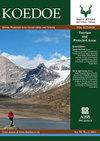花岗岩链上的生物和非生物连接:多学科研究框架
IF 1.1
4区 环境科学与生态学
Q3 BIODIVERSITY CONSERVATION
引用次数: 8
摘要
稀树草原异质性的概念已经成为克鲁格国家公园(KNP)管理的基础,并影响了如何管理火、人工地表水和大型食草动物来维持、模仿或在某些情况下恢复固有的异质性。关于稀树草原背景下从小尺度到大尺度的不同层次异质性概念的概述,以及它如何影响KNP的思维和管理,请参见Du Toit, Rogers和Biggs(2003年版)和Rogers(2003年版)。“异质性”是一个广义的术语,但可以包括土壤类型和性质、植被组成和结构、斑块和模式、亚栖息地、动物存在等之间的差异和相互作用。在潜在尺度上的局部环境梯度创造了从山顶到山坡溪流的生态格局。自底向上驱动程序与自顶向下控制程序相互作用,从而产生这些模式。进行了一个多学科项目,以研究克鲁格国家公园南花岗岩超级遗址三级集水区连系带的功能、结构和异质性的过程。该项目包括非生物成分(如地下水-地表水相互作用、土壤化学和物理性质)以及生物成分(如土壤微生物、短暂水池中的小型水生生物、植物群落、植被结构和哺乳动物多样性)。每一个组成部分都沿着垂直梯度进行了详细的研究,并在本期特刊的单独文章中进行了报道。2015-2016年的干旱发生在研究的采样期,包括植被和哺乳动物对干旱的响应信息。在这篇文章中,综合了来自不同组成部分或学科的研究结果,以突出链的相互作用功能和生态模式。这些发现随后被用于在类似环境中开发多学科研究的框架。该框架强调了生态系统各组成部分之间的相互关系以及多学科方法的重要性。本文章由计算机程序翻译,如有差异,请以英文原文为准。
Biotic and abiotic connections on a granitic catena: Framework for multidisciplinary research
The concept of savanna heterogeneity has been fundamental in how this has informed the management of the Kruger National Park (KNP), and has influenced, for example, how fire, artificial surface water and large herbivores are managed to maintain, mimic or, in some cases, restore inherent heterogeneity. For an overview of the concepts of heterogeneity in the savanna context on different levels from a fine to a broader scale, and how that has influenced thinking and management of the KNP, see Du Toit, Rogers and Biggs (ed. 2003) and Rogers (2003). ‘Heterogeneity’ is a broad term, but can comprise differences and interactions between soil types and properties, vegetation composition and structure, patchiness and patterns, sub-habitats, animal presence and so on. Local environmental gradients on a catenal scale create ecological patterns from the crest to the stream of the hillslope. Bottom-up drivers interact with top-down controls to give rise to these patterns. A multidisciplinary project was conducted to study the processes that govern functioning, structure and heterogeneity on a catena in a third-order catchment in the Southern Granite Supersite in the Kruger National Park. The project included abiotic components (e.g. groundwater-surface water interactions, soil chemical and physical properties) as well as biotic components (e.g. soil microbes, small aquatic organisms in ephemeral pools, plant communities, vegetation structure and mammal diversity). Each of these components was investigated in detail along the catenal gradient and reported on in separate articles in this special issue. The drought of 2015–2016 occurred during the sampling period of the study and information on the response of vegetation and mammals to the drought were included. In this article, a synthesis of findings from the separate components or disciplines is provided to highlight the interactive functioning and ecological patterns of the catena. These findings were then used to develop a framework for multidisciplinary studies in similar environments. The framework highlights the interactive relationships between various components of the ecosystem and the importance of a multidisciplinary approach.
求助全文
通过发布文献求助,成功后即可免费获取论文全文。
去求助
来源期刊

Koedoe
BIODIVERSITY CONSERVATION-
CiteScore
3.30
自引率
0.00%
发文量
10
审稿时长
20 weeks
期刊介绍:
Koedoe, with the subtitle ''African Protected Area Conservation and Science'', promotes and contributes to the scientific (biological) and environmental (ecological and biodiversity) conservation practices of Africa by defining the key disciplines that will ensure the existence of a wide variety of plant and animal species in their natural environments (biological diversity) in Africa.
 求助内容:
求助内容: 应助结果提醒方式:
应助结果提醒方式:


